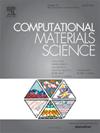A decision transformer approach to grain boundary network optimization
IF 3.1
3区 材料科学
Q2 MATERIALS SCIENCE, MULTIDISCIPLINARY
引用次数: 0
Abstract
As microstructure property models improve, additional information from crystallographic degrees of freedom and grain boundary networks (GBNs) can be included in microstructure design problems. However, the high-dimensional nature of including this information precludes the use of many common optimization approaches and requires less efficient methods to generate quality designs. Previous work demonstrated that human-in-the-loop optimization, instantiated as a video game, achieved high-quality, efficient solutions to these design problems. However, such data is expensive to obtain. In the present work, we show how a Decision Transformer machine learning (ML) model can be used to learn from the optimization trajectories generated by human players, and subsequently solve materials design problems. We compare the ML optimization trajectories against players and a common global optimization algorithm: simulated annealing (SA). We find that the ML model exhibits a validation accuracy of 84% against player decisions, and achieves solutions of comparable quality to SA (92%), but does so using three orders of magnitude fewer iterations. We find that the ML model generalizes in important and surprising ways, including the ability to train using a simple constitutive structure–property model and then solve microstructure design problems for a different, higher-fidelity, constitutive structure–property model without any retraining. These results demonstrate the potential of Decision Transformer models for the solution of materials design problems.

晶界网络优化的决策转换方法
随着微观结构特性模型的改进,来自晶体自由度和晶界网络(GBNs)的附加信息可以包含在微观结构设计问题中。然而,包含这些信息的高维性质排除了许多常见优化方法的使用,并且需要效率较低的方法来生成高质量的设计。之前的研究表明,以电子游戏为例,人在循环优化实现了这些设计问题的高质量、高效解决方案。然而,获得这样的数据是昂贵的。在目前的工作中,我们展示了如何使用决策转换器机器学习(ML)模型从人类玩家生成的优化轨迹中学习,并随后解决材料设计问题。我们比较了ML优化轨迹与玩家和一种常见的全局优化算法:模拟退火(SA)。我们发现ML模型对玩家决策的验证准确率为84%,并且实现了与SA(92%)相当质量的解决方案,但是使用了三个数量级的迭代。我们发现机器学习模型以重要和令人惊讶的方式进行了推广,包括使用简单的本构结构-属性模型进行训练的能力,然后无需任何再训练即可解决不同的、更高保真度的本构结构-属性模型的微观结构设计问题。这些结果显示了决策变压器模型在解决材料设计问题方面的潜力。
本文章由计算机程序翻译,如有差异,请以英文原文为准。
求助全文
约1分钟内获得全文
求助全文
来源期刊

Computational Materials Science
工程技术-材料科学:综合
CiteScore
6.50
自引率
6.10%
发文量
665
审稿时长
26 days
期刊介绍:
The goal of Computational Materials Science is to report on results that provide new or unique insights into, or significantly expand our understanding of, the properties of materials or phenomena associated with their design, synthesis, processing, characterization, and utilization. To be relevant to the journal, the results should be applied or applicable to specific material systems that are discussed within the submission.
 求助内容:
求助内容: 应助结果提醒方式:
应助结果提醒方式:


